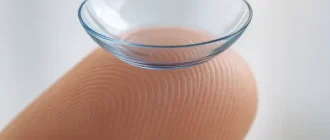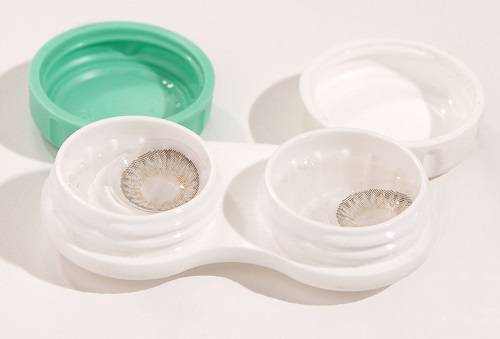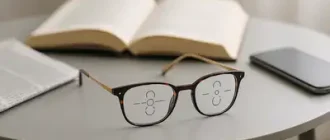Night driving can be challenging, even for the best drivers. Glare from headlights, reduced visibility, and blurry lights all contribute to increased difficulty—and stress—when driving at night. If you’ve ever found yourself squinting to see the road or feeling uneasy behind the wheel after dusk, you’re not alone. Studies suggest that about 40% of drivers are uncomfortable driving at night, and issues with night vision only increase with age. Let’s dive into what makes night driving tough, and how choosing the right lenses or glasses can make a world of difference.
Why is Night Driving So Hard? The Science Behind It
Night driving requires our eyes to adapt to constantly changing levels of light, making it harder to focus and differentiate objects clearly. The average driver’s vision is roughly 10 times worse at night than during the day. Here’s why:
- Reduced Visual Acuity: The human eye simply doesn’t function as well in low light. Visual acuity can drop by up to 50% in nighttime conditions, which is why even familiar roads can seem unrecognizable after dark.
- Glare Sensitivity: The contrast between darkness and the intense light of oncoming headlights causes significant glare. Studies show that older drivers are especially vulnerable—glare recovery time can be up to 8 seconds for those over 60 compared to just 2 seconds for younger drivers.
- Pupil Reaction Time: In low light, our pupils widen to allow in more light. However, this also means that bright headlights create overwhelming flashes, making it hard for us to adjust.
The result is often eyestrain, slower reaction times, and a higher risk of accidents. In fact, statistics from the National Safety Council indicate that more than 50% of traffic fatalities occur at night, even though there is significantly less traffic.
Types of Lenses for Better Night Driving: What Are Your Options?
When it comes to night driving, there are several lens options available that can help improve visibility. Let’s explore the top contenders:
| Type of Lens | Description | Benefits | Drawbacks |
|---|---|---|---|
| Anti-Reflective (AR) Coated Lenses | Lenses with a special coating that reduces glare from lights | Reduces glare from headlights and streetlights, improves contrast | Can be more expensive compared to standard lenses |
| Yellow-Tinted Lenses | Lenses with a light yellow tint, meant to filter blue light | Enhances contrast and reduces glare, may work well in dimly lit conditions | Effectiveness is debated—some studies suggest limited impact on glare |
| Polarized Lenses | Lenses that reduce reflected light, commonly used for sunglasses | Effective at reducing glare during daylight, may reduce reflections from wet surfaces | Not recommended for night driving—may reduce overall visibility |
| Photochromic Lenses | Lenses that adjust to light conditions (darken in sunlight) | Convenient for day-to-night transitions, some UV protection | Do not darken in car due to UV-blocking windshields, limited usefulness at night |
Anti-Reflective (AR) Coated Lenses are the most recommended for night driving. The AR coating reduces internal reflections within the lens, allowing more light to pass through, resulting in clearer vision. Several drivers have reported feeling a significant reduction in headlight glare when using AR lenses.
Yellow-Tinted Lenses are sometimes marketed as night-driving glasses, but their effectiveness is debatable. A 2019 study from Harvard Medical School found that while yellow lenses may improve contrast in certain low-light environments, they did not significantly reduce glare from oncoming headlights. Despite the mixed reviews, some drivers do find that they feel more comfortable wearing yellow-tinted lenses during dusk or dawn.
Blue Light: The Hidden Culprit in Night Driving?
An emerging area of interest is the impact of blue light on night driving. Blue light is emitted by LED headlights, which are increasingly popular because of their efficiency and brightness. Unfortunately, they are also linked to increased glare and discomfort at night.
Dr. Nathaniel Brooks, an optometrist specializing in night vision issues, explains: “Blue light scatters more easily in the atmosphere, leading to greater glare sensitivity. It’s one of the reasons why LED headlights can feel blinding compared to traditional halogen lights.” While blue light blocking lenses are gaining popularity, evidence is still inconclusive about their impact on night driving specifically. However, blocking some blue light may reduce overall eye fatigue during prolonged drives.
What Do Real Drivers Say? Practical Experiences with Night Driving Lenses
To understand the practical side of things, here are some insights from real drivers:
- Samantha, 45, from Florida: “I got anti-reflective lenses last year, and they made a huge difference. Glare from headlights doesn’t bother me as much, and I feel more confident driving at night. It’s definitely worth the extra cost.”
- Michael, 58, from New York: “I tried the yellow-tinted glasses because I heard they help with night driving. Honestly, I didn’t see much of a difference. I still struggle with the glare from those bright LED headlights.”
- Dr. Susan Martinez, a practicing optometrist: “I recommend AR-coated lenses to my patients who have trouble driving at night. The coatings help reduce the intensity of headlights, and the difference can be quite remarkable, especially for older drivers.”
Emerging Trends: The Future of Night Driving Vision
In recent years, technological advancements have sparked new developments in the world of eyewear for driving. Adaptive Driving Glasses—which adjust to varying light conditions—are currently being researched, but are not yet widely available. These glasses use photochromic technology with rapid adaptation times, allowing them to respond dynamically to the changes in light intensity encountered during night driving. If brought to market, these could be a game changer for drivers struggling with varying levels of glare.
Another exciting trend is the incorporation of augmented reality (AR) HUDs (Heads-Up Displays) directly into windshields. These displays project important information—such as speed limits or road hazards—into the driver’s line of sight, reducing the need for drivers to refocus their eyes. While not a direct replacement for corrective lenses, this technology has the potential to mitigate some of the challenges associated with poor night vision.
Our Editorial Team’s Advice for a Safer Night Drive
Night driving doesn’t have to be intimidating. With the right tools and knowledge, you can significantly improve your comfort and safety behind the wheel. If you find night driving uncomfortable, consider anti-reflective coated lenses—they remain the gold standard for reducing headlight glare and enhancing clarity. Avoid yellow-tinted glasses unless you specifically notice improvement in your vision. And remember, it’s always best to visit an eye care professional to determine what solution fits your unique needs.
As technology evolves, more innovative solutions will undoubtedly emerge. Until then, a pair of well-chosen lenses can make all the difference. Stay safe out there, and remember—it’s okay to slow down and be cautious. A confident driver is always a safer driver.





